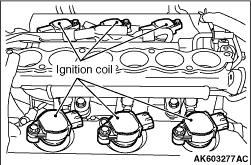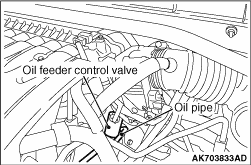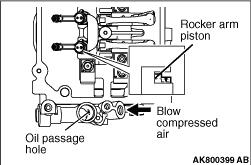
2.Remove the rocker cover.
 |
1.Remove all of the ignition coils. 2.Remove the rocker cover. |
 |
3.Remove the oil control valve. 4.Remove the oil pipe. 5.Turn the crankshaft clockwise until the notch on the crankshaft pulley is lined up with "T" mark on the lower cover of timing belt. |
 |
7.While shutting up the oil passage hole at the depth of the oil control valve’s
installation hole by finger not to leak air, blow compression air into the oil pipe installation
hole by air blowgun. At this time, confirm that the rocker arm piston can operate.
9.Confirm the rest of the rocker arm pistons under the procedure 7. 10.When the rocker arm piston does not operate, replace the rocker arm assy. 11.Install the oil pressure switch and the oil control valve. (Refer to Camshaft and valve Stem Seal - Removal and Installation  .) .)12.Install the rocker cover. 13.Install all of the ignition coils. |